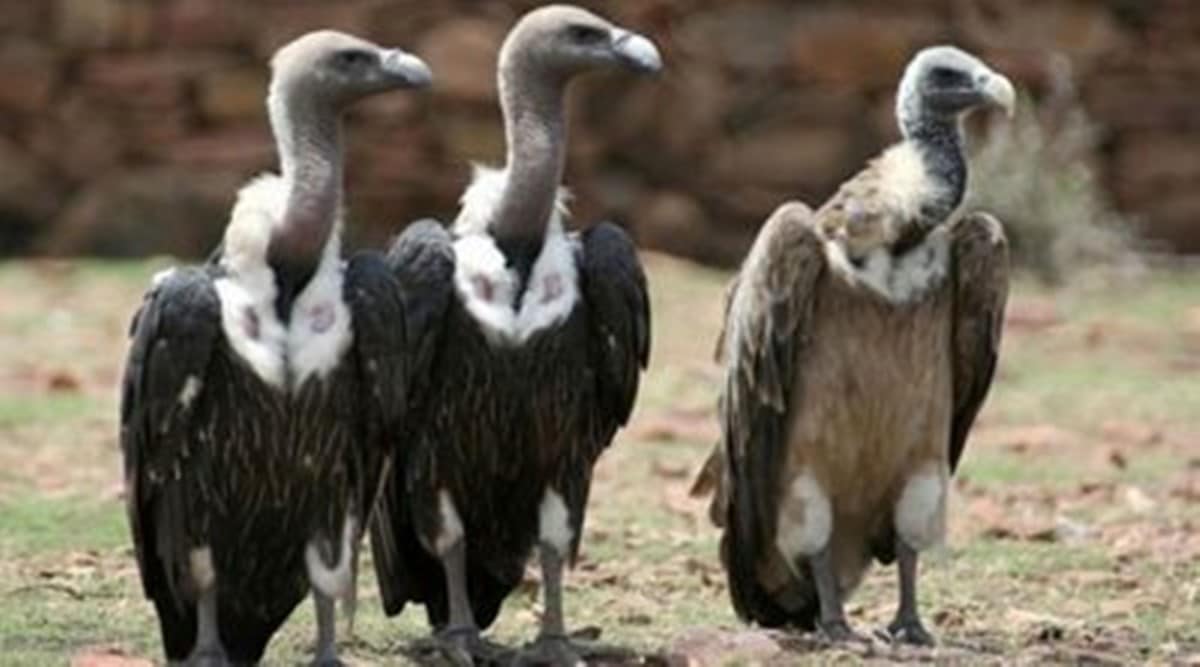 According to a vulture census, conducted by the state government over the past two decades, the bird’s population in Gujarat was estimated to be 2,647 in 2005.(Representational/Express Photo)
According to a vulture census, conducted by the state government over the past two decades, the bird’s population in Gujarat was estimated to be 2,647 in 2005.(Representational/Express Photo) Compensating farmers for the losses they incur after vultures build nests in their farms and building cafeterias or platforms where animal carcasses can be kept for the winged scavengers to feed on, are some of the steps being taken by the state government to help conserve vultures, whose numbers have been dwindling for the past few decades, the Gujarat Assembly was told during the ongoing budget session.
In response to an unstarred question on the status of vulture population in Gujarat by Congress MLA Kantibhai Parmar, the state government, in a written reply, stated the vulture population dropped from 999 in 2016 to 819 in 2018 when the last survey of the birds was conducted. This is an 18 per cent decline in the vulture population in just two years.
According to a vulture census, conducted by the state government over the past two decades, the bird’s population in Gujarat was estimated to be 2,647 in 2005. It declined to 1,431 in 2007, 1,065 in 2010, 1,043 in 2012 and came down to just 999 individuals in 2016.
The highest number of vultures are found in Junagadh (147 individuals), Anand (94), Bhavnagar (88), and Banaskantha (79) districts. In 2018, sizable numbers of the bird were found in Sabarkantha (63), Mehsana (59), Valsad (54), and Ahmedabad (50) districts. At least 15 districts, including Bharuch, Navsari, Surat, and Vadodara, have no resident vulture population.
Among the steps taken to help in the recovery of the vulture population in Gujarat, the state government said it is trying to create awareness among cattle rearers not to use diclofenac – a drug used in treating cattle but considered deadly for vultures. In 2004, Gujarat was among the first states in India to ban the use of diclofenac.
The state said it is also compensating farmers for losses caused after vultures build nests in their farms. It is also trying to preserve large trees, which can be used by the birds to build nests, and put up signages urging people to protect the species.
The ‘Vultures, the Feathered Scavengers in Gujarat’, a book published by Gujarat Ecological Education and Research (GEER) Foundation in 2019, notes that the state government is paying Rs 500 compensation per nest to farmers in case vultures build nests on their coconut palms and destroy coconuts in the process.
Shyamal Tikadar, the principal chief conservator of forests (PCCF) and chief wildlife warden of Gujarat, told The Indian Express Tuesday, “We are also building vulture cafeterias which are fenced enclosures where carcasses are kept so that vultures can feed on them. One such cafeteria has been developed in Junagadh. To understand the ecology of these birds, we are satellite-tagging vultures. So far, we have satellite-tagged eight vultures.”
The GEER Foundation book, authored by GEER Foundation director RD Kamboj and GEER Foundation scientists Ketan Tatu and Sandeep Munjapara, records vulture cafeterias have been set up in Bhavnagar, Kutch, and Surat districts. A Vulture Conservation and Breeding Centre is also functioning out of Sakkar Baug Zoo in Junagadh since 2009 and has successfully overseen captive breeding of vultures.
The government also stated that it is mapping the nests of these birds, their feeding sites, night-halt sites and local water bodies.
Bird Facts:
Of the 23 species of vultures, nine species — white-rumped vulture (WRV), long-billed vulture (LBV), read-headed or king vulture (KV), Egyptian vulture (EV), Eurasian griffon (EG), Himalayan griffon (HG), cenereous vulture (CV) slender-billed vulture (SBV) and bearded vulture (BV) — are found in India. Except slender-billed and bearded vultures, the rest are found in Gujarat.
Of the 819 vultures recorded during the 2018 Census, 352 were WRV, 285 KV, 148 EV, and the rest of other species.
The number of vultures rose in eight districts with the largest spike of 21 recorded in Anand district, according to the 2018 Census. Their population declined in 13 districts — the biggest drop of 63 birds was seen in Amreli district.